inside
• Immunity tips for kids
• Health benefits of aloe
• Flavorful taco recipes


inside
• Immunity tips for kids
• Health benefits of aloe
• Flavorful taco recipes

Watermelon pops up at almost every barbecue, pool party, and picnic. It’s easy to see why: Watermelon boasts 92 percent water content, making this tasty fruit both refreshing and hydrating.
The lycopene in watermelon may also protect against harmful UV exposure, which increases during the longer days of summer.
Watermelon is a great pick-me-up after a day at the beach or a strenuous summer hike. A good source of vitamin B6, which helps fuel the body by breaking down proteins, watermelon also contains antioxidants and potassium that can help the body recover after exercising.
Each 1-cup serving of watermelon contains fewer than 50 calories, making it the perfect summer snack. Watermelon chunks make great additions to salads, grain bowls, smoothies, and more.

Here are some tips for making the most of the season’s bounty:
✔ When choosing a watermelon, prioritize firmness, symmetry, and heft—you want a fruit heavy for its size.
✔ A round yellow patch on the flesh is okay— even desirable—as that is where the melon sat on the ground while it was growing. Avoid fruits with a lot of bruises, cuts, and dents.
✔ Always wash watermelons in cool water and pat dry before preparing and eating. Make sure your cutting surface and tools are clean too.
✔ Once cut, fresh watermelon can last for up to three days in the refrigerator. ●
SELECTED SOURCES “Summer is time for kids to try new foods” by Jessica Cording, Academy of Nutrition and Dietetics, www.EatRight.org • “Watermelon,” US Department of Agriculture SNAP-Ed Connection, www.snaped.fns.usda.gov





From National Watermelon Day on the third through National Relaxation Day on the 15th and National Beach Day on the 30th, August is full of reasons to celebrate. One of summer’s fun foods, watermelon is a key ingredient in many picnics and barbecues. It’s also hydrating and full of nutrients. See just how good it is for you on page 2.
Called the “healing wonder,” aloe (aloe vera) is useful in the summer for burns and skin irritation. But it also has many other healing properties. Learn about them beginning on page 24, and try the accompanying smoothie recipe.
All year round, probiotics feed the bacteria that keep the digestive tract running smoothly. Certified nutritionist Sally Karlovitz looks at the benefits of probiotics for gut health and the prebiotics that feed them (page 17).
We cover lung health this month (page 20) and feature an adult nutrition chart that lists the micronutrients the body needs, the foods that provide them, and how much of each an adult body needs (page 22).
Ready to head to the kitchen? Our food feature this month, beginning on page 12, is all about tacos, for Tuesday or any day. There’s advice to make weekly meal prep easy in our cook-at-home department (page 26). And if you’ve thought about going vegan—or are just curious about veganism—see page 28.
If there are kids in your kitchen, help them make their own energy bars with the recipe on page 5. They’re nutritious, delicious, and easy! August signals the beginning of a new school year. Whatever grades your children are in, check out our tips to keep them healthy as they go back to the classroom. See pages 16 and 18.
Enjoy a bountiful, healthy August!

Contributing Writers
Mary Ann O’Dell MS, RDN
Sally Karlovitz CN
Chief Content Officer and Strategist
Lynn Tryba (Lynn.Tryba@TasteforLife.com)
Contributing Editors
Lisa Fabian, Rich Wallace
Associate Editor
Kelli Ann Wilson
Creative Director
Michelle Knapp
Custom Graphics Manager
Donna Sweeney
Chief Operating Officer
Amy Pierce
Customer Service
800-677-8847
CustomerService@TasteforLife.com
Client Services Director - Retail Judy Gagne (x128)
Client Services Director - Advertising & Digital Ashley Dunk (x190)
Vice President – Retail Sales and Strategic Partnerships
Anna Johnston (Anna.Johnston@TasteforLife.com)
Chairman and Founder T. James Connell
Taste for Life® (ISSN 1521-2904) is published monthly by CCI, 155 Washington Street, Keene NH 03431, 603-283-0034 (fax 603-283-0141); © 2024 Connell Communications, Inc. All rights reserved. Subscription rates: $29.95. This magazine is not intended to provide medical advice on personal health conditions, nor to replace recommendations made by health professionals. The opinions expressed by contributors and sources quoted in articles are not necessarily those of the editor or the publisher. Advertisers and advertising agencies assume liability for all content of advertising and for any claims arising therefrom. Information appearing in Taste for Life may not be reproduced in whole or in part without express permission of the publisher.
Creative and Sales Offices 155 Washington Street, Keene NH 03431 603-283-0034


Mary Ann O’Dell, MS, RDN


a note on recipes Nutritional analysis from Edamam. Nutritional values vary depending on portion size, freshness of ingredients, storage, and cooking techniques. They should be used only as a guide. Star ratings are based on standard values (SVs) that are currently recommended:

20 min prep time + 1 hr chill time makes 12 bars
From The Complete DIY Cookbook for Young Chefs ($19.99, America’s Test Kitchen, 2020)
2 c whole almonds
¼ tsp salt
1½ c dried cranberries
1½ c chopped pitted dates
2 Tbsp water
¼ tsp vanilla extract
1. Line an 8-inch square metal baking pan with plastic wrap, letting excess hang over sides of pan.
2. Add almonds and salt to a food processor and lock the lid into place. Turn on processor and process until almonds are finely ground, 20 to 30 seconds. Stop processor and remove lid.
3. Add cranberries, dates, water, and vanilla to processor and lock lid back into place. Hold down pulse button for 1 second and then release. Repeat until fruit is finely chopped and mixture starts to clump together, about fifteen 1-second pulses. Stop processor, remove lid, and carefully remove processor blade.
4. Use a rubber spatula to transfer mixture to plastic-lined baking pan, and spread into an even layer. Fold excess plastic over top and use your hands to press mixture firmly to flatten.
5. Place baking pan in the refrigerator and chill until firm, about 1 hour.
6. Transfer chilled mixture to a cutting board and discard plastic. Slice mixture in half, and then cut each half crosswise into 6 pieces (you should have 12 bars). Serve. (Bars can be refrigerated in an airtight container for up to 1 week.)
Per serving (1 bar): 278 Calories, 6 g Protein, 0 mg Cholesterol, 43 g Carbohydrates, 34 g Total sugars (0 g Added sugars), 6 g Fiber, 12 g Total fat (1 g sat), 50 mg Sodium, ★★★★ Vitamin E, ★★ Vitamin B2 (riboflavin), ★ Magnesium, Phosphorus


Eating well appears to have an extra benefit for breast cancer survivors: A healthy diet lowers their risk of heart disease. A new report from Oxford University Press notes that breast-cancer survivors have higher rates of cardiovascular disease than the general population, often because of their cancer treatment.
A lengthy study of more than 3,000 survivors found fewer incidences of heart failure, arrhythmia, cardiac arrest, and related problems in those whose eating patterns adhered most closely to the DASH diet (Dietary Approaches to Stop Hypertension). That plan emphasizes fruit, nuts, vegetables, whole grains, lean protein, and low-fat dairy, while limiting red meats, processed meats, and sweetened beverages.
SELECTED SOURCES “Diet quality and cardiovascular disease risk among breast cancer survivors in the Pathways Study” by I.J. Ergas et al., JNCI Cancer Spectrum, 4/24 • “Healthy diet lowers heart disease risk in breast cancer survivors,” Oxford University Press USA, 4/17/24
Adding a daily cup of beans or chickpeas could raise your diet quality by up to 20 percent, according to one new estimate. The legumes are rich in dietary fiber, potassium, magnesium, iron, folate, and choline, which often fall short in the typical American diet.
SELECTED SOURCES “Adding more beans to the US typical dietary pattern can lead to greater intake of shortfall nutrients and a higher diet quality in younger and older adults” by Y. Papanikolaou et al., Maturitas, 4/30/24 • “New study shows eating beans and chickpeas is linked to better diet quality in American adults,” www.Eurekalert.org, 6/4/24


Multitasking while eating may lower the enjoyment of the meal and lead to over-snacking later, according to a new study.
Researchers asked 122 participants (mostly young women ages 18 to 24) how much they expected to enjoy their lunch prior to eating it. The women then ate under one of three conditions: with no distraction, with moderate distraction (watching a video), and with high distraction (while playing an online game). Those who ate while distracted reported less enjoyment and satisfaction from the meal. They also tended toward increased snacking later “and a more general desire for further gratification.”
SOURCE “Why do we overindulge?,” American Psychological Association, 5/16/24

Employees in a digital workspace tend to be better protected against stress, anxiety, and overload if they exhibit a higher degree of mindfulness, according to a new study. “We found that being mindfully and confidently digital should be considered important elements of living a healthy digital working life in the 21st century,” said lead researcher Elizabeth Marsh. Mindfulness is defined as a state of consciousness that involves paying attention in the present moment intentionally and without judgment. The study determined that workers who were more mindful and confident were less impacted by “the dark side effects” of the digital workplace.
SELECTED SOURCES “Mindfully and confidently digital: A mixed methods study on personal resources to mitigate the dark side of digital working” by E. Marsh et al., PLOS ONE, 2/23/24 • “Mindfulness at work protects against stress and burnout,” University of Nottingham, 2/23/24

Fuel your muscles with this thirstsatisfying protein boost. The super simple formula supplies 10 grams upcycled protein from barley, and a refresh of essential amino acids for muscle repair.* It has a clean, refreshing taste that won’t weigh you down. No artificial sweeteners or flavors. No added sugar.

Renowned for its potential respiratory benefits, mullein has been used for centuries to support lung health.* Infused with mint flavor, these drops provide a convenient, pleasant, and invigorating taste experience, making them a delight to incorporate into your daily routine.
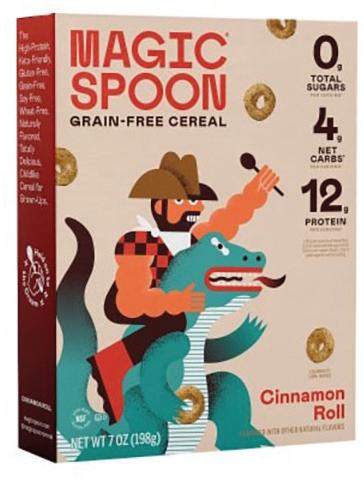
Enjoy childhood classic flavors with grown-up ingredients. This grain free cereal is high protein and keto friendly. It has zero grams added sugar—no cane sugar, corn syrup, or sugar alcohols. Each serving provides 12–14 g protein and just 4 g net carbs. It’s your favorite cereal, reimagined.

Enjoy pre-seasoned tempeh crumbles with a bold blend of peppers for a just-right heat that will elevate any dish and delight your tastebuds. Supplies 16 g of protein and 6 g fiber per serving. It’s a cultured and fermented plantbased superfood, perfect for use in tacos, quesadillas, chili, and more!

A convenient formula for life on the go, these supplements are clinically shown to support a healthy stress response.* They start working in 30 minutes to relieve stress., and help support a positive outlook and reduce irritability after four weeks of daily use. Delicious Orange Mango Saffron flavor.

Why repel with chemicals when you can hide with botanicals! When applied, this luxe formula masks the scent of human skin and tricks bugs into sensing you’re a flower they instinctively avoid. In a non-toxic, pesticidefree process you will become bite-proof while also nourishing and hydrating skin.

This woof-worthy flavor comes from sustainable, pasture-raised, grass-fed elk. The protein-packed treats include elk as the first ingredient, plus upcycled flax seed to help reduce waste. Made without artificial colors, flavors, or preservatives. For every O.T.I.S. product purchased, $1.00 goes to support Medical Dog programs.

Get a natural source of phospholipidbased DHA and EPA essential fatty acids with caviar extract, a completely natural, whole-food source of Specialized Pro-resolving Mediators (SPMs). This bioavailable combination provides a powerful anti-inflammatory effect throughout the body, restoring your brain, heart, skin health, and more.*



















40 min prep time makes about 8 empanadas
From the Taste for Life test kitchen
1 Tbsp oil, divided
12 oz ground turkey or ground chicken
1 tsp chili powder
½ tsp garlic powder
½ tsp ground cumin
½ tsp salt
¼ c green salsa, plus additional for serving
15 oz (425 g) store-bought pie pastry dough
1 egg, beaten
1. Preheat oven to 375˚. Lightly grease a baking sheet with 1 teaspoon of the oil.
Are you in a taco rut? Looking for something different than the same old tastes stuffed into shells? These recipes will have you enjoying new and interesting ingredients in salads, empanadas, and more.

2. Heat remaining 2 teaspoons of oil in a large pan. Add ground meat and sauté for 1 minute. Add chili powder, garlic powder, cumin, and salt. Continue sautéeing until meat is cooked through. Stir in the ¼ cup of salsa.
3. Place ¹⁄³ of the dough onto a lightly floured surface. Roll dough out to ⅛-inch thickness. Cut circles out of dough with a 6-inch round cookie cutter. Re-roll out scraps and remaining dough as needed, cutting out circles until you have 8.
4. Place about 2½ to 3 tablespoons of filling in center of each dough circle. Dampen pastry edges with water. Fold dough
over filling to make a half-moon shape. Pinch edges of dough to seal. Repeat with remaining dough and filling. Brush tops of empanadas with beaten egg.
5. Bake empanadas on baking sheet for 15 minutes, or until golden brown. Serve with additional salsa.
Kitchen Note: This recipe uses storebought pie crust, so you don’t have to make your own empanada dough from scratch. Per serving (2 empanadas; made with ground turkey): 450 Calories, 29 g Protein, 99 mg Cholesterol, 54 g Carbohydrates, 6 g
(0
35 min prep time serves 4
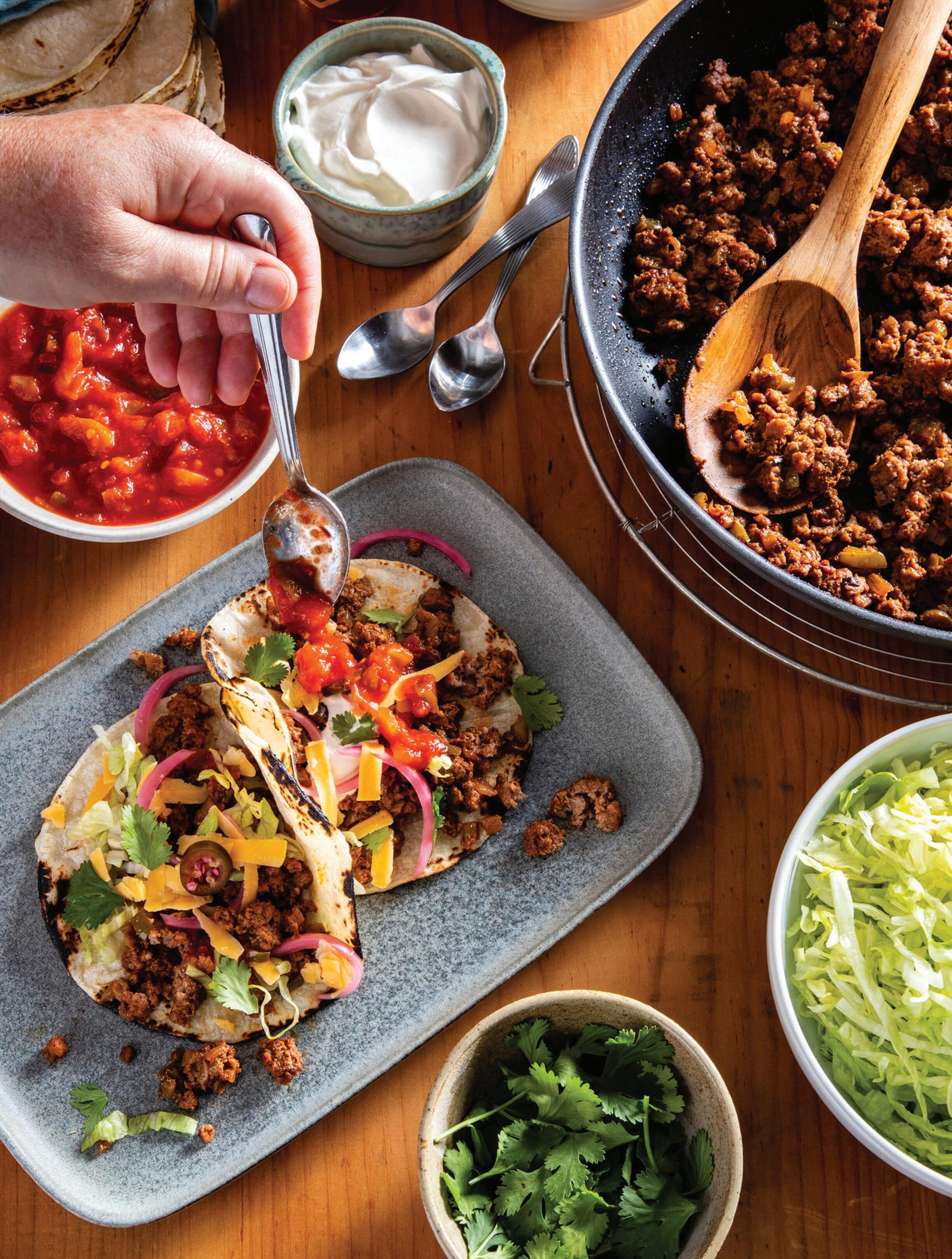
From Cooking with Plant Based Meat by America’s Test Kitchen ($27.99, America’s Test Kitchen, 2022)
1 Tbsp vegetable oil
1 onion, chopped fine
1 green bell pepper, stemmed, seeded, and chopped fine
½ tsp salt
4 garlic cloves, minced
1 Tbsp chili powder
1 tsp ground cumin
½ tsp black pepper
¼ tsp cayenne pepper (optional)
2 Tbsp tomato paste
12 oz plant-based ground meat
½ c water
12 (6 inch) corn tortillas, warmed
1. Heat oil in a 12-inch nonstick skillet over medium heat until shimmering. Add onion, bell pepper, and salt. Cook until softened and lightly browned, 5 to 7 minutes.
2. Stir in garlic, chili powder, cumin, pepper, and cayenne, if using. Cook until fragrant, about 30 seconds. Stir in tomato paste and cook until rust-colored, 1 to 2 minutes.
3. Stir in ground meat and cook, breaking up meat with a wooden spoon, until firm crumbles form, about 3 minutes. Stir in water and simmer until sauce is thickened, about 1 minute. Divide filling evenly among tortillas and serve.
Kitchen Note: The spice level of chili powder varies greatly by brand. If you don’t like a little heat, or if you’re unsure of how spicy your chili powder is, feel free to omit the cayenne. Serve with your favorite taco toppings.
Per serving (tacos only; no toppings): 422 Calories, 21 g Protein, 0 mg Cholesterol, 44 g Carbohydrates, 4 g Total sugars (0 g Added sugars), 8 g Fiber, 20 g Total fat (4 g sat), 546 mg Sodium, ★★★ Vitamin C, Phosphorus, ★★ Vitamin B6, Iron, ★ Vitamin B1 (thiamine), B3 (niacin), E, Calcium, Magnesium, Potassium, Zinc
25 min prep time
+ prep time for pickled cabbage serves 4
From The Weekday Vegetarians Get Simple by Jenny Rosenstrach ($32.99, Clarkson Potter, 2024)
1 tsp toasted sesame oil
2 Tbsp neutral oil or olive oil
16 oz mushrooms, any kind, stems trimmed, sliced
½ small yellow onion, finely chopped
3 Tbsp sweet white miso*
1 tsp sriracha
2 Tbsp hot water
8 (5 inch) corn tortillas or hard-shell tacos
Rice Vinegar-Pickled Cabbage (recipe follows)
1. In a large skillet, heat sesame and neutral oils over medium heat. Add mushrooms and cook until mushrooms have mostly released all their liquid, 8 to 10 minutes. Add onion and cook until softened, 4 to 5 minutes.
2. Meanwhile, in a small bowl or measuring cup, whisk together miso, sriracha, and hot water until mixture is consistency of ketchup.
3. Stir miso mixture into mushrooms, and then remove mushrooms from heat.
4. Heat oven to 350°. If you are using hardshell tacos, place them on a sheet pan in the oven, about 3 minutes. If using corn tortillas, place each one on a gas burner for about 10 seconds per side, until tortilla is slightly charred. (If you don’t have a gas burner, warm each in a nonstick or cast-iron pan set over medium-high heat.) Remove and keep warm under a foil tent.
5. When ready to serve, stuff each taco shell or tortilla with about ¹⁄³ cup of the mushroom filling. Top with scallions and pickled cabbage.
*Miso is a fermented soybean paste. It’s typically found in the refrigerated section. Look for gluten-free versions if you wish to keep this recipe free of gluten.
Kitchen Note: Consider adding your favorite toppings to these tacos, including avocado, cilantro, and jalapeño.
Per serving (made with hard-shell tacos; topped with scallions and pickled cabbage): 299 Calories, 8 g Protein, 0 mg Cholesterol, 37 g Carbohydrates, 15 g Total sugars (9 g Added sugars), 5 g Fiber, 15 g Total fat (3 g sat), 605 mg Sodium, ★★★★ Vitamin B2 (riboflavin), ★★★ Vitamin B3 (niacin), K, ★★ Vitamin B6, C, Phosphorus, ★ Folate, Magnesium, Potassium, Zinc

¹⁄³ c unseasoned rice vinegar*
3 Tbsp sugar
2 tsp kosher salt
2 c shredded cabbage (any kind: red, green, Napa, savoy)
½ tsp red pepper flakes
1. In a heavy medium saucepan, combine vinegar, sugar, salt, and 2½ cups water. Bring to a boil over high heat, stirring occasionally. When sugar has dissolved, add shredded cabbage and pepper flakes, reduce heat to low, and simmer, uncovered, until shreds have wilted, about 4 minutes.
2. Remove pan from heat and set aside to cool to room temp. You can use pickled cabbage immediately, or chill in an airtight container for up to 7 days.
*You can substitute red wine vinegar or apple cider vinegar for the rice vinegar.
45 min
prep time
+ prep time for pickled onion and tortilla croutons serves 4

From The Salad Lab by Darlene Schrijver ($32.50, S&S/Simon Element, 2024)
Start Out
½ c Quick Pickled Onions (recipe follows)
²⁄³ c quartered cherry tomatoes
Whisk
½ c smashed avocado
¼ c sour cream or Mexican crema
¼ c avocado oil
2 Tbsp very finely diced, seeded, and deveined fresh jalapeño
2 Tbsp fresh lime juice, plus ½ tsp lightly packed grated lime zest
1 Tbsp finely chopped fresh cilantro
2 tsp Mexican hot sauce
Flaky sea salt and freshly cracked black pepper
Toss
4 c thinly shredded green cabbage or savoy cabbage
3 c thinly shredded red cabbage
²⁄³ c cubed peeled mango (½ inch pieces)
1½ c Cheesy Tortilla Croutons (recipe follows)
2 tsp chipotle chili powder or chili powder
1 Tbsp plus 1 tsp avocado oil, divided
½ tsp sea salt
1 lb white fish such as mahi mahi, cod, or tilapia, cut into 1-inch cubes
½ c crumbled Cotija cheese or grated Monterey Jack cheese
¼ c finely chopped fresh cilantro Lime wedges, for serving
1. Start out: Prepare pickled onions 30 minutes or up to 1 day in advance. Place tomatoes in a colander, and gently press down with a spoon to drain off excess liquid.
2. Whisk: In a large salad bowl, add avocado, sour cream, the ¼ cup of avocado oil, the jalapeño, lime juice and zest, cilantro, and hot sauce. Season with salt and pepper. Whisk until well combined, and then taste and adjust seasoning, if needed.
3. Toss in bowl with dressing, add green and red cabbages, mango, pickled onions, and tomatoes. Toss until all ingredients are evenly combined and coated with dressing. Let salad marinate while you finish toppings.
4. Prepare cheesy tortilla croutons and keep warm.
5. In a small bowl, whisk together chipotle powder, the 1 teaspoon of avocado oil, and the salt. Add fish and gently toss until well combined.
6. Heat a large, well-seasoned cast-iron skillet over medium-high heat. Add remaining 1 tablespoon avocado oil and tilt pan to entirely
coat bottom. Add fish and cook for 2 minutes. Flip fish and cook for another 2 minutes.
Flip and continue cooking for 1 to 2 minutes longer if needed until fish is opaque all the way through. Gently remove from pan.
7. Add warm fish directly to bowl of tossed cabbage mixture. Sprinkle top with warm croutons, cheese, and cilantro. Serve immediately with lime wedges on side for squeezing over salad.
Per serving (made with cod and Monterey Jack cheese): 565 Calories, 32 g Protein, 80 mg Cholesterol, 35 g Carbohydrates, 13 g Total sugars (2 g Added sugars), 8 g Fiber, 35 g Total fat (9 g sat), 1,104 mg Sodium, ★★★★★ Vitamin B6, B12, C, K, Phosphorus, ★★★ Vitamin B1 (thiamine), B3 (niacin), Calcium, Folate, ★★ Vitamin A, B2 (riboflavin), Magnesium, Potassium, ★ Vitamin E, Iron, Zinc
From The Salad Lab by Darlene Schrijver ($32.50, S&S/Simon Element, 2024)
¾ c white distilled vinegar or apple cider vinegar
¾ c water
1 Tbsp sugar
½ tsp sea salt
1½ c quartered and sliced red onion (about 1 medium)
1. In a small pan, combine vinegar, water, sugar, and salt. Cook over medium heat until sugar and salt have dissolved, about 4 minutes.
2. Pour brine into a large glass jar. Add onion slices, stirring and pressing them down in liquid until they are evenly coated.
3. Let sit 30 minutes at room temperature or refrigerate overnight.
From The Salad Lab by Darlene Schrijver ($32.50, S&S/Simon Element, 2024)
¼ c crumbled Cotija cheese or Monterey Jack cheese
¼ c grated sharp Cheddar cheese
2 (6 inch) flour tortillas
1. In a small bowl, mix Cotija and Cheddar cheeses. Heat a skillet over medium-high heat until you see faint wisps of smoke.
2. Place half of cheese mixture in center of pan and spread out evenly in a circle the same size as tortillas. Place a tortilla on top and cook, flipping once cheese is melted, crispy, and browned, 2 to 3 minutes. Heat other side of tortilla until starting to brown, another minute or so.
3. Transfer to a wire rack to cool. Repeat with remaining cheese and tortilla. Cut into ½-inch pieces and use right away.
BY

From grade school to high school, August signals backto-school time and the time to get supplies. As you buy back-to-school supplies, be sure you include supplies to maintain good health. Everyone knows that kids going back to school can mean colds and other infections that can spread through the entire family, so stock up on supplies now to nurture and nourish your kids and keep them (and you) well.
✔ Healthy Foods. Always have healthy options available for breakfast and after school. Kids in school should never skip breakfast. Make it easy with plain instant oatmeal with fresh fruit and nuts, or whole grain toast with nut or seed butter. If time is an issue, mix up a shake with plain yogurt, fruit, and a green foods powder, or choose a nutritious fruit and nut bar to eat on the go. For the afternoon, make sure plenty of healthy snacks are available at home, including apples and nut butter, pita chips and hummus, carrot sticks, and cheese sticks. Guard against excess sugar intake from sweets, soda, and juices. Excess sugar can weaken the immune system, making a child more susceptible to infections like colds and flu.
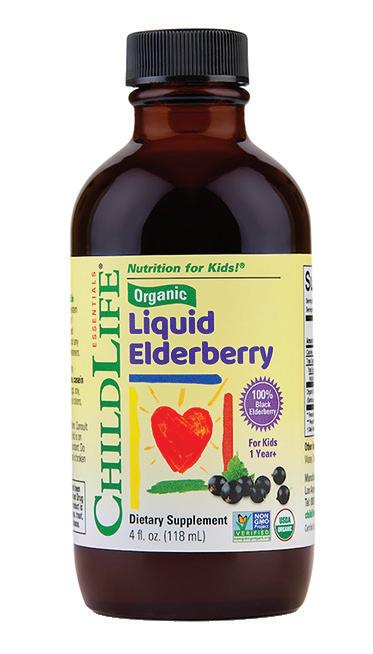
ChildLife Essentials
Organic Liquid Elderberry
Powerful immune system support.*
Supplies 1,200 mg elderberry per 1 teaspoon serving.*
No added sugar, artificial flavors, or sweeteners.
Safe and effective for toddlers and kids ages 1+.*
✔ Daily Multivitamin. Add a high-quality daily multivitamin. Let’s face it . . . kids do not always make the best food choices. A daily multivitamin/ mineral supplement ensures that the basic nutrient requirements for growing and adolescent children are met, especially if there are gaps in the diet. Look for natural formulas that do not contain the artificial colors, flavors, or sweeteners that you’ll find in a lot of wellknown children’s cartoon vitamins.
✔ Supplement Support. For added brain power, consider an omega-3 DHA formula. Omega-3 fatty acids are highly concentrated in the brain and appear to be particularly important for cognitive and behavioral development and function.
To enhance the immune and digestive system, add probiotics. These beneficial organisms, found in yogurt and other fermented foods, are an excellent way to boost immunity and keep bad bugs and viruses in check. Finally, keep some general immune support formulas on hand to deal with any seasonal challenges, including colds and flu. Look for ingredients like elderberry and vitamin C for general immune support. ●
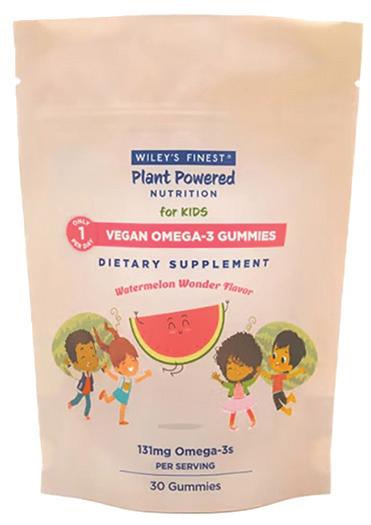
Wiley’s Finest Plant Powered Vegan Omega-3 Gummies
Formulated using a unique blend of algal oil and ahiflower seed oil. 250 mg of omega 3s per serving. Tangy watermelon flavor, with just enough sweetness to make taking omega 3s easy and fun.
BY SALLY KARLOVITZ,

When we hear the term bacteria, we often think of the negative: illness and infection that can occur from pathogenic bacteria. But some bacteria are actually GOOD. In fact, the key factor in the immunity of the intestines is all the friendly bacteria that colonize the gut, commonly known as probiotics. The name “probiotic” comes from Greek and means “for life.” There are between 400–500 different species of probiotics that reside in the gastrointestinal (GI) tract, and these organisms play vital roles in human health.
✔ Digestion. Probiotics aid digestion of complex carbohydrates, milk lactose, and proteins.
✔ Nutrient Availability. Probiotics enhance absorption of certain nutrients, including B vitamins.
✔ Yeast Control. Probiotics help suppress overgrowth of yeast, such as candida, in the GI tract.
✔ Immune Support. Probiotics encourage an acidic intestinal environment which strongly inhibits undesirable or harmful bacteria and yeasts that can contribute to illness and infection.
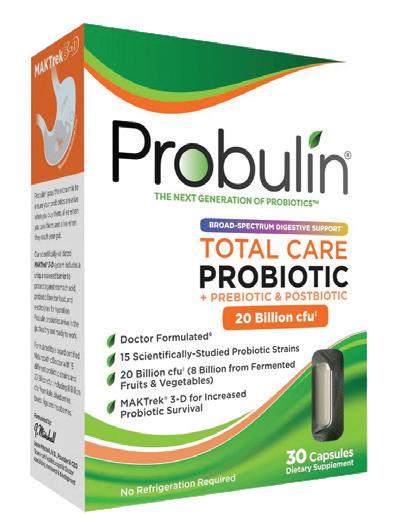
Probulin
Total Care Probiotic + Prebiotic & Postbiotic
Broad-spectrum support for digestive and immune function.*
Prebiotic + probiotic + postbiotic that supports total gut health.*
Supplies 15 clinically studied probiotic strains.
Includes fermented fruit and vegetable blend.
✔ Overall GI Health. Probiotics protect and promote the health of the GI tract, including the lining of the intestinal tract. They encourage balance in the intestinal tract, which supports overall regularity. This action can also help reduce the negative intestinal effects of antibiotics.
✔ Mood Health. Since scientists have discovered neurons in the GI tract that communicate like neurons in the brain, there has been an increased focus on the gut-brain connection. Controlling inflammation in the GI tract and supplementing with probiotics may result in more GI balance and improvement in brain function and symptoms of mild depression. Unfortunately, many things in life can deplete or diminish good bacteria: poor diet, stress, illness, and the use of antibiotics. To build up and maintain probiotics in the body, it is important to include fermented foods in the diet, such as yogurt, kefir, kombucha, and kimchi or kraut. Supplements containing concentrated amounts of beneficial probiotic organisms are also available, with formulas for infants to seniors and everyone in between.
Along with probiotics, there is growing evidence supporting the use of prebiotics. Prebiotics are nondigestible carbohydrates that go through the digestive system and help good bacteria grow and flourish. Basically, they are food for probiotics. Prebiotics are derived mostly from plant fibers and have been shown to improve digestion, enhance the absorption of minerals, strengthen the immune system, and help reduce the likelihood of colorectal cancer. Look for formulas with chicory, inulin, or acacia. ●
The start of a new school year is a stressful time for kids, and it can also cause bouts of anxiety for parents—especially those whose children can’t eat gluten. Fortunately, there are ways to control your child’s gluten exposure.
✔ Identify risks. Field trips, cafeteria lunches, cooking classes, sporting events, and clubs are some of the situations where gluten may be present. Be sure your child knows exactly what foods are off-limits.
✔ Inform teachers and school administrators. Request meetings with your child’s teachers and principal. Detail your child’s diet and stress the severity of accidental gluten exposure. If you can, meet before the school year starts.
✔ Know what will be served for school lunches. Find out from the school dietitian, or person in charge of food preparation, what the lunch menus will be. Discuss the options with your child. You may be more comfortable making their lunches. Be sure your child understands why swapping food with other kids is not safe. Keep your child’s lunchbox offerings fun and interesting so they’ll be less likely to swap.
✔ Obtain a birthday schedule. Know in advance when classroom parties will be held. This helps you prepare and coordinate with other parents.
✔ Provide gluten-free treats for the classroom.
There will be instances when someone unexpectedly brings in gluten-filled treats for the classroom, or your child’s supply of gluten-free treats runs out. While this will be disappointing, teach kids to politely decline anything with gluten. You’ll both feel better for it. ●
SELECTED SOURCES “Back-to-school and 504 plan guide,” Celiac Disease Foundation, www.Celiac.org • “Back to school toolkit,” www.BeyondCeliac.org

Going back to school is exciting, but there are some things to keep in mind regarding kids’ physical and mental health. Experts at Johns Hopkins Medicine offer the following tips to supports kids as they make the transition back to the classroom:
• Begin school-year routines, including earlier bedtimes, a week or two before school starts.
• Arrange for kids to spend time with classmates during summer vacation to help maintain social connections.
• Younger children may struggle with longer school days, transitions, and sitting still—be patient and supportive as they adjust to these new challenges.
• To keep viruses at bay, encourage hand washing for at least 20 seconds— after toileting and before snacks and meals.
• Remind children not to share utensils, cups, and food items (especially if they have food allergies or sensitivities).
SOURCE “Back-to-school guide for parents,” Johns Hopkins Medicine, https://HopkinsMedicine.org

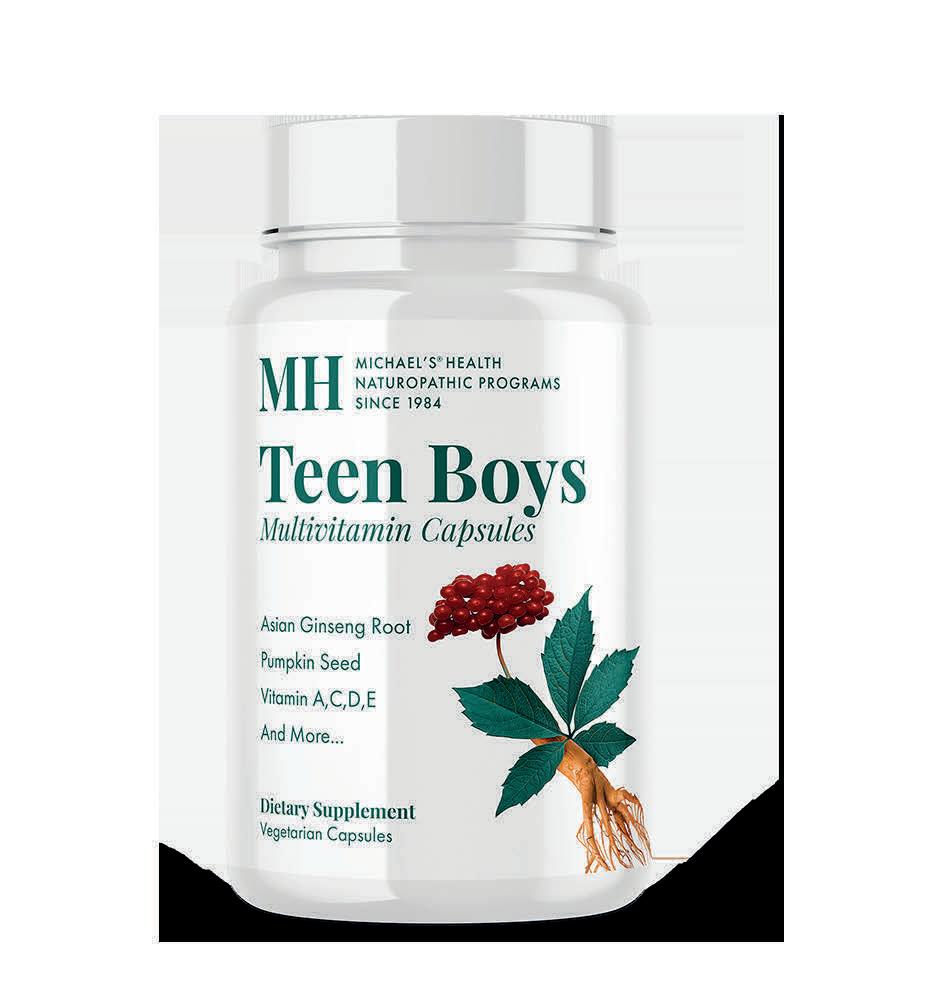






How many times a day do you draw a breath? And how often do you think about it?
A normal, healthy breathing rate for an adult at rest is 12 to 18 breaths per minute, according to the Cleveland Clinic, or from 17,280 to 25,920 per day. That’s a lot of activity for something most people pay little or no attention to. More than 25 respirations per minute when at rest, or fewer than 12, may signal a health problem.
All the cells in the body require oxygen, and the nose, mouth, bronchial tubes, and lungs—collectively called the airways—get it to them. Healthy airways mean efficient and comfortable breathing.
“Lungs at rest and during most daily activities are only at 50 percent of their capacity,” says Rush University Medical Center respiratory therapist Gagan Singh, RRT. “Like the rest of your body, lungs thrive on movement and activity.”
More intense activity, says Singh, helps the lungs cleanse themselves, counteracting “the buildup of toxins and tar in the lungs caused by environmental pollutants, allergens, dust, and cigarette smoke.”
A healthy diet that includes fruit, fiber, vegetables, and healthy fats is good for your whole body, reducing both inflammation and the risk of lung diseases.
Because they offer a wealth of nutrients, add to your eating plan as many of the following foods as possible:

apples, beets, tomatoes, grapefruit, berries, Brazil nuts, walnuts, pumpkins, chili peppers, and red cabbage. Olive oil and green tea also add antioxidant and antiinflammatory benefits to your diet.
Lower your intake of processed meats including cold cuts, fatty and salty potato chips, and bread and other baked goods made with overly processed white flour. Switch to whole grains.
The lungs benefit from water as much as the rest of the body does. “Staying well hydrated by taking in fluids throughout the day helps keep the mucosal linings of the lungs thin, [which] helps the lungs function better,” says Singh.
If you experience any of the following symptoms, seek help from your healthcare provider: shortness of breath; pain when breathing; or cough, wheezing, or dizziness when exercising.
Regular health checkups can help you stay ahead of airway and lung problems and take care of them before they get serious.
SELECTED SOURCES “9 tips for healthy lungs,” Rush University Medical Center, www.rush.edu • “Foods that you should and should not eat for healthier lungs,” Family Care Centers Medical Group, www.fccmg.com, 3/10/23 • “Tips for maintaining optimal airway health,” Foundation for Airway Health, www.airwayhealth.org, 11/12/23 • “Vital signs: What is a respiratory rate?” Cleveland Clinic, https://my.ClevelandClinic.org, 3/15/23
• Make the effort to breathe deeply so that your belly expands when you breathe. Breathe more slowly and evenly. Sit and stand up straighter. When seated, “occasionally sit tall and reach overhead to make more room for your lungs,” Singh suggests.
• If you smoke, it’s time to quit, hard as that may be, since it lowers the efficiency of the lungs as well as damaging airways. Also avoid secondhand smoke, which contains toxins and can damage the lungs.
• Improve your indoor air environment by making sure there’s good ventilation; cleaning regularly; and using air purifiers can help cut down on airborne allergens, pollutants, mold spores, and dust mites so they don’t find their way into your lungs.

• To improve the functioning of your lungs, get plenty of exercise, which helps them push oxygen to every call in your body. Physical activity also strengthens the muscles of the respiratory system.
• Get more laughter in your life: It’s “a great exercise to work the abdominal muscles and increase lung capacity,” according to Singh. Plus, it forces out stale air, allowing “fresh air to enter into more areas of the lung.”

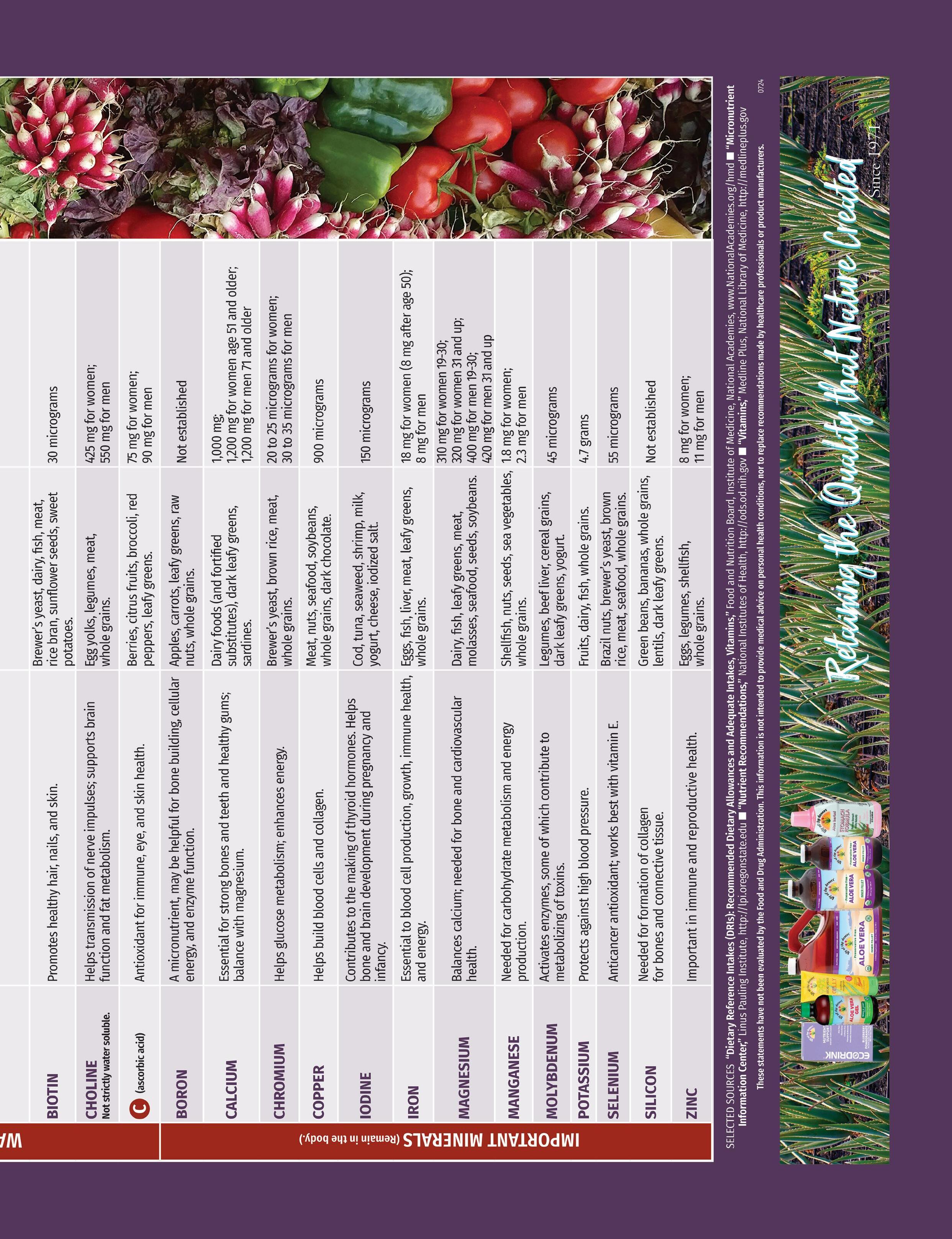
BY MARY ANN O’DELL, MS, RDN

Aloe vera has been called the “healing wonder” because of its uses for so many problems inside and outside the body. The aloe vera plant hax been used medicinally for over 5,000 years. Aloe vera was used by the Greek physician Dioscorides for treatment of everything from constipation to burns. It was used by Queen Cleopatra to preserve her skin against the harsh Egyptian sun. It has been used throughout history and is still used today, both topically and internally.
Ease Indigestion. Aloe vera is naturally rich in enzymes, making it useful to help improve digestion. In addition, it can help provide relief from heartburn. Compounds present in aloe can help naturally control acid release in the stomach. This action,

Paragon Plus™
Whole Leaf Filtered Aloe Vera Juice
Provides all the nutritional and soothing benefits of aloe vera.*
No preservatives added.
Made with organically grown aloe vera.
along with its known soothing and anti-inflammatory properties, makes aloe vera juice a great option to keep on hand to help combat gastric ulcers.
Improve Gut Health. Aloe vera juice is used internally to coat, soothe, and heal the intestinal tract and to improve digestion. Because it has anti-inflammatory properties, it can help calm inflammation in the esophagus, stomach, and gut. For this reason, some people who have irritable bowel syndrome have found relief using aloe vera juice internally. Both aloe vera juice and aloe vera gel can support gut regularity. Aloe vera gel acts as a mild laxative and is also healing to the lining of the intestinal tract.
Enhance Nutritional Status. One study also found that aloe vera taken internally enhanced the absorption of vitamins C and B12, increasing antioxidant status in test subjects. Taking daily vitamin C and B-vitamins supplements with aloe juice instead of water could help improve the bioavailability of these nutrients.
Promote Oral Health. Aloe vera juice is known to be antiviral and anti-inflammatory, making it a great ingredient for oral health care. Research suggests aloe vera may help improve periodontitis and canker sores. The juice can be swished in the mouth, just like a mouthwash, and it may help control bacteria that causes cavities.
Soothe & Support Skin. Aloe vera gel is used topically to soothe sunburns or heal cuts and rashes.

The gel is a natural moisturizer containing vitamin C, enzymes, and amino acids. It penetrates and hydrates the skin, and can help relieve pain, acting as a mild anti-inflammatory agent. Research also suggests oral aloe vera can help skin, with one study showing that taking aloe vera gel increased collagen production and improved skin elasticity over a 90-day period.
With its mild taste, aloe vera juice can be consumed by itself or mixed into fruit juice or your favorite smoothie. A general dose is up to 8 ounces per day of aloe vera juice.
As is true with all supplements, if you are taking any medications, discuss the internal use of aloe vera juice or gel with your health care provider prior to use. ●

Replenish, moisturize, and hydrate skin.
Cools and soothes skin.
Made with certified organic aloe vera juice/gel.
No parabens.

Recipe courtesy lilyofthedesert.com
Even if you’re not a fan of the taste of aloe vera, you’ll like this recipe. The orange juice delivers that sweet citrus flavor (and vitamin C) that’s so refreshing and simply delicious!
1 cup freshly squeezed orange juice
½ cup aloe vera
¼ tsp sea salt
1 cup ice
1. Combine the orange juice, aloe vera, and sea salt in a blender.
2. Add the ice and blend until smooth.
3. Pour into a chilled glass. Garnish with an orange slice and mint leaves if desired.
If you’re like many people, you don’t want to spend hours in the kitchen. But you still want to eat healthy and tasty meals. How can you make good food without a massive investment of time? It’s possible, but it does require some planning.
Here are some tips and tricks to help meals come together with less time and effort.
Spend a few minutes thinking about what you’d like to eat over the week. After you’ve decided, make a list of the ingredients you’ll need as well as those you already have.
Start slow when it comes to meal prepping. Don’t go full in and try to prep for five or more meals. Begin with three or four. It’ll be less stressful and more sustainable.
Sunday’s not the only day to meal prep. Look at your schedule for the week. If a Tuesday or Wednesday works better than the weekend, go for one of those days instead.
Make sure you have enough high-quality, fridge- and freezer-safe containers to store prepped ingredients. If you’re going to reheat food in the microwave, opt for glass containers.
Start a session of meal prepping with the recipe that takes the longest to prepare. While it’s roasting, simmering, or slow cooking, prep ingredients for another dish.
Take shortcuts. Purchase bottled marinades, dressings, and sauces to speed up the cooking process. Buy pre-chopped onions, garlic, ginger, and herbs from the store. Varieties typically come frozen, packaged in tubes or cubes as pastes, or marinated in oils or vinegars. Keep a batch of cooked noodles in the fridge, so it’s ready to add to a soup or stir-fry.
Store purchased, frozen mashed potatoes in the freezer. Top shepherd’s pies, make potato pancakes, or serve as a quick side.
When time allows, make extra batches of pastry dough. Freeze for future sweet and savory recipes. In the mood for pizza, but don’t have a frozen crust on hand or the time to make your own dough? Substitute naan or a flatbread for a quick and tasty swap.
Roast a large tray of vegetables. Keep in the fridge to add to salads, stir-fries, pastas, egg dishes, and grain bowls.
Extra batches of rice and homemade stock don’t take that much longer to prepare. And freezing them for future recipes can save lots of time. Place in the fridge the night before to defrost.

If you make your own salad dressings, double or triple the amount. Keep in the fridge in a sealed jar for up to two weeks.
Make a few cups of lentils and beans when you have some extra time. Add to last-minute salads (see Herby Lentil Bowls with Feta & Pomegranate recipe here), grain dishes, and soups.
It’s true: If you wash, peel, cut, and chop veggies when you get them home from the store, you’re more likely to use them (and snack on them!) throughout the week.
Meal prepping doesn’t mean dinners only. Consider prepping batches of breakfasts, or assembling lunches ahead of time.
Last, but certainly not least: If you’re the one who handles the planning, prepping, and cooking for everyone else, don’t be afraid to ask for some help when it comes time to prepare ingredients. ●
SELECTED SOURCES “3 strategies for successful meal planning” by B. Gordon, Academy of Nutrition and Dietetics, www.EatRight.org, 2/19/24 • “12 expert-approved tips to make meal prep easier” by D.A. White, www. FoodNetwork.com, 10/30/19 • Kitchen Sanctuary Quick & Easy by Nicky Corbishley ($26.99, Kyle Books, 2024) • “Meal prep guide,” The Nutrition Source, Harvard T.H. Chan School of Public Health, https://nutritionsource. hsph.harvard.edu



10 min prep time serves 6
From Kitchen Sanctuary Quick & Easy by Nicky Corbishley ($26.99, Kyle Books, 2024)
1 lb, 2 oz cooked green or Puy lentils
1 (14 oz) can chickpeas, drained and rinsed
7 oz cherry tomatoes, quartered
1 small red onion, peeled and finely diced
3½ oz fresh cilantro, chopped
3½ oz fresh flat-leaf parsley, chopped
1¾ oz fresh mint, chopped
Seeds from 1 pomegranate or 9 oz ready-prepared seeds
7 oz feta cheese, crumbled
Dressing
2 Tbsp fresh lemon juice
3 Tbsp olive oil
1 Tbsp miso paste*
1 Tbsp honey
¼ tsp ground black pepper
1. Put cooked lentils in a large serving bowl. Add chickpeas, tomatoes, onion, cilantro, parsley, mint, pomegranate, and feta. Toss together to combine.
2. Mix together dressing ingredients in a small jug or bowl. Pour over lentil salad and toss together. Serve.
*Miso is a fermented soybean paste. It’s typically found in the refrigerated section. Look for gluten-free versions if you wish to keep this recipe free of gluten.
Kitchen Note: This is a beautifully fragrant tabbouleh-style salad that uses green lentils instead of bulgur wheat. There’s no cooking involved—more of a gathering of ingredients—so it’s really quick to put together. It contains lots of fresh herbs, which act almost like salad leaves but give the dish extra freshness. The miso paste gives a lovely extra umami hit.
Per serving: 781 Calories, 42 g Protein, 29 mg Cholesterol, 115 g Carbohydrates, 20 g Total sugars (3 g Added sugars), 22 g Fiber, 20 g Total fat (6 g sat), 527 mg Sodium, ★★★★★ Vitamin B1 (thiamine), B2 (riboflavin), B6, C, K, Folate, Iron, Phosphorus, Zinc, ★★★ Calcium, Magnesium, Potassium, ★★ Vitamin A, B3 (niacin), B12, E
Veganism has been gaining momentum for quite some time, and its rising popularity makes it easier than ever to adopt a plant-based lifestyle. Whether you’ve decided to switch to a vegan diet to help prevent the exploitation of animals, to improve your health, to promote sustainability, or all the above, you’ll find an abundance of resources and products to smooth the way.
Here are three easy ways to get started with a plantbased diet.
q Veganize your favorites. You likely already have some vegan meals in your repertoire, along with vegetarian meals that can be easily “veganized.” Think bean-based chili, pasta and veggies, lentil stew, and stir fry, for instance.
r Start slowly. Begin with just one plant-based meal per day. You might try breakfast—hot or cold cereal with fruit, nuts, and soy, oat, or almond milk will fuel your morning. Or ease into vegan living by gradually upping the number of plant-based foods on your plate and decreasing the amount of meat, eggs, and dairy.
s Educate yourself. Read about veganism, join online forums, talk with longtime vegans, and watch documentaries on living a plantbased life. Be a savvy shopper: Not all vegan products are labeled “vegan,” and some items that you think will pass the test don’t—some pasta has egg in it, for instance, and some cornbread mixes contain animal fat.
If you’re following a vegan diet, be sure you’re getting enough of the nutrients commonly provided by meat, fish, and dairy foods, including vitamins B12 and D, calcium, iodine, iron, omega-3 fatty acids, and zinc. While some of these nutrients are provided by plant foods, and by fortified plant foods, supplementation may be necessary.
To avoid vitamin B12 deficiency, you may need to supplement two or three times a week. Calcium can be another tricky nutrient for vegans: Many supplements get their calcium from oyster shells; others come in gelatin capsules. It’s worth looking for a vegan calcium supplement with magnesium and vegan vitamin D. Since most omega 3s come from fish oil and krill, look for vegan forms of their constituent fatty acids, DHA and EPA (docosahexaenoic acid and eicosapentaenoic acid), which can be provided by algae instead. Have your blood levels checked if deficiency is suspected, and always consult your healthcare practitioner before adding any new supplements to your regimen. ●

SELECTED SOURCES “The impact of a vegan diet on many aspects of health: The overlooked side of veganism” by A. Bali and R. Naik, Cureus, 2/15/23 • “Plantbased diets and long-term health: Findings from the EPIC-Oxford study” by T.J. Key et al., Proceedings of the Nutrition Society, 5/22 • “Nutrient intake and status in adults consuming plant-based diets compared to meat-eaters: A systematic review” by N. Neufingerl and A. Eilander, Nutrients, 11/23/21 • “Vegan vitamins & supplements buying guide” by E. Marcus, www.Vegan. com • “What is a plant-based diet and why should you try it?” by K.D. McManus, Harvard Health Publishing, https://Health.Harvard.edu, 3/28/24

Need help getting started with vegan cooking?
You can find lots of tasty and nutritious vegan recipes at TasteforLife.com/vegan
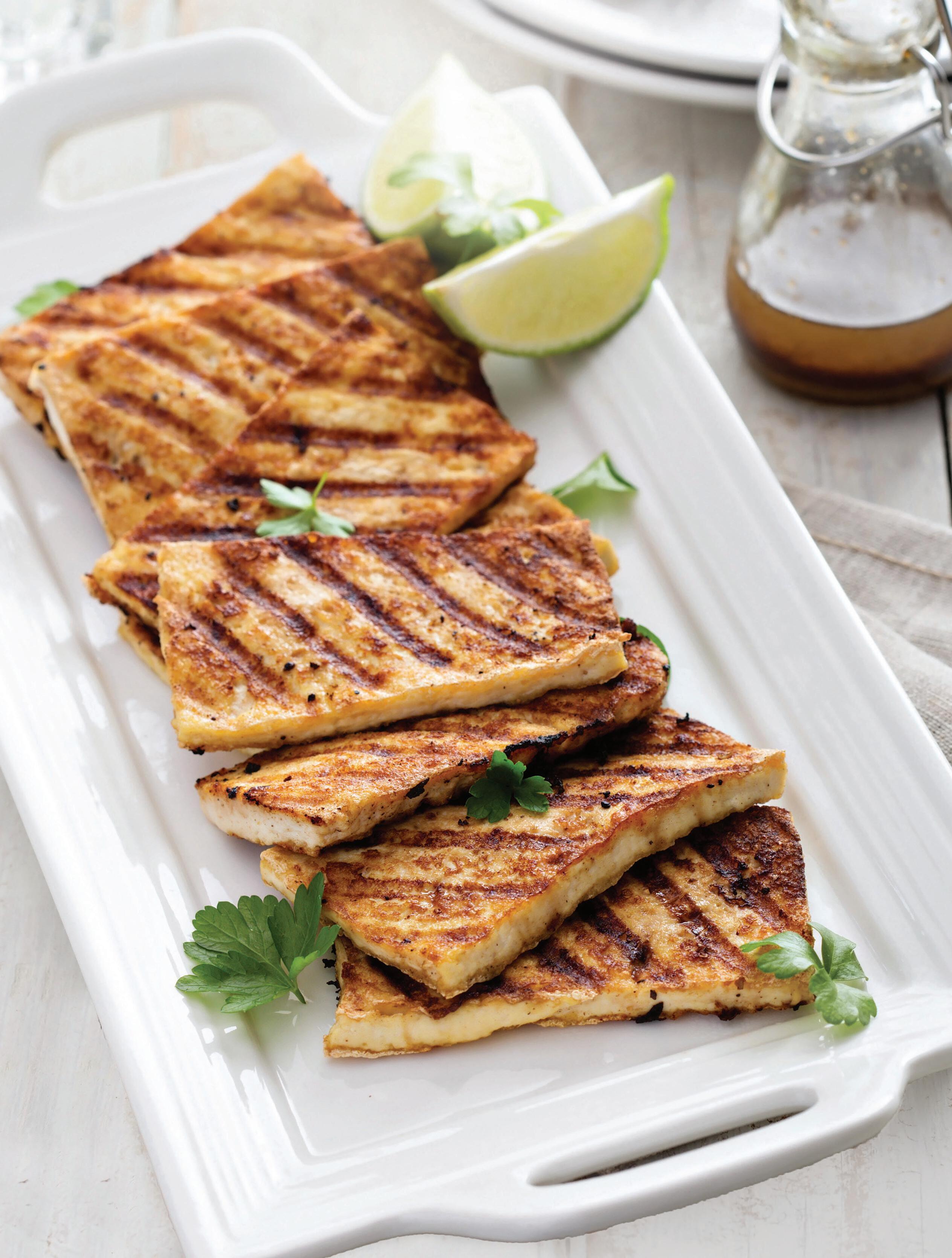
40 min prep time serves 4
From the Taste for Life test kitchen
1 c fresh Italian parsley leaves
1 c fresh cilantro leaves
1 garlic clove, chopped
¼ c extra-virgin olive oil
2 Tbsp lemon juice
Salt and freshly ground black pepper
1 (14 oz) package extra-firm tofu, drained
1 Tbsp vegetable oil, plus additional for grill
1. In a high-speed blender, purée parsley, cilantro, garlic, extravirgin olive oil, lemon juice, and salt and pepper to taste until smooth. Set aside.
2. Slice drained tofu into 12 slices. Lay slices on a rimmed baking sheet lined with a clean kitchen towel or paper towels. Top tofu slices with another clean towel or layer of paper towels. Place another baking sheet on top. Set a heavy skillet on baking sheet to remove water from tofu. After 15 minutes, remove tofu and pat dry.
3. Brush tofu with the 1 tablespoon of vegetable oil. Season to taste with salt and pepper. Lightly oil grill grates with additional vegetable oil.
4. Grill tofu slices 3 minutes per side, or until lightly charred. Remove tofu from grill. Brush with herb sauce. Serve remaining sauce on side.
Kitchen Note: Tofu has been a staple of vegan diets for decades. If you’re looking for a new way to enjoy this classic ingredient, why not toss it on the grill? The herb sauce adds a fresh burst of flavor.
Per serving: 198 Calories, 9 g Protein, 4 g Carbohydrates, 2 g Fiber, 18 g Total fat (3 g sat), 313 mg Sodium, ★★★★★ Vitamin K, ★★ Vitamin C, Calcium, ★ Vitamin E, Folate, Iron, Magnesium, Phosphorus


























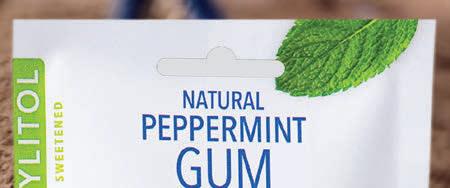










Comfortable, convenient period protection. Antibacterial menstrual cup made of 100% medical grade silicone.
Better for you, and better for our planet!

Maximum Living MineralRich
Liquid mineral supplement with 70 ionic trace minerals + 8 macro minerals.
Contains B12 to promote sustainable energy.*
Plus biotin and silica.




KAL
Liposomal Iron + C
Red blood cell production support.*
18mg iron + 18mg vitamin C.
High absorption, with liposomal technology.
Gentle on digestion.
Paragon PlusTM
Kid’s Calm Chewable
Supports relaxation, clarity, and focus.*
Chewable formula with L-theanine, magnesium, GABA, and a botanical blend.
Natural mixed fruit flavor. Melatonin free.
Carlson Omega-3s with SPMs
Promotes healthy brain aging, and cellular and skin health.* With specialized pro-resolving mediators (SPMs).
SPMs support your body’s defense system and normal inflammatory response.*
Deep Steep Body Wash, Rosemary Mint
Enjoy a rich, creamy lather with gentle, effective cleansing.
Leaves skin feeling soft and smooth. Refreshing herbal aroma with invigorating rosemary and mint.

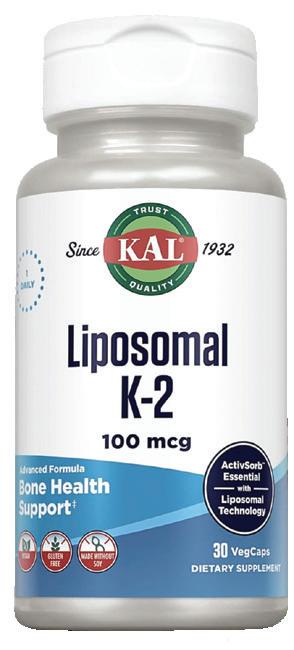
Emerald Labs Women’s 45+ 1-Daily Multi
Formulated for the unique health needs of women 45+.*
With coenzyme B vitamins and chelated minerals.
Plus CoQ10, vitamin K2, antioxidants, and a whole food blend.
Bone health support.*
Delivers 100mcg of K2, the perfect daily dose.*
High absorption, with liposomal technology.
Gentle on digestion.

3005
LAKE MARY
LAKE MARY
LAKE MARY
3005 W Lake Mary Blvd 407-936-9470
3005 W Lake Mary Blvd 407-936-9470
Lakewood Ranch 6574 University Pkwy Sarasota , FL 34240 *These statements have not
3005 W Lake Mary Blvd 407-936-9470 Altamonte Springs 1086
East Orlando
4924 E Colonial Dr 407-228-1373
, FL 34240 *
Altamonte Springs 1086 Montgomery Rd 407-774-8866
Lakeland
4001 US Highway 98 N 863-815-0001
4001 US Highway 98 N 863-815-0001
Kissimmee
Kissimmee 1114 N John Young Pkwy 407- 846-7454
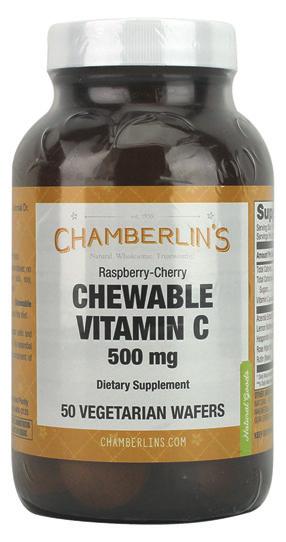
Chamberlin's Chewable Vitamin C 500mg
Support the immune system.*
Supports collagen formation and capillary strength.* With rose hips, acerola, and bioflavonoids.
Natural raspberry-cherry flavor.
*These statements have not been evaluated by the Food & Drug Administration. These products are not intended to diagnose, treat, cure, or prevent any disease. This information is presented as general information and is not meant to replace medical advice. Because persons and circumstances can vary, self treatment may not be right for you. Consult a qualified health care practitioner for advice pertaining to any particular person or case or before beginning any new exercise, diet, or supplementation program. Use products only per label direction.
*These statements have not been evaluated by the Food & Drug Administr ation These products are not intended to diagnose, treat, cure, or prevent any disease This information is presented as gener al information and is not meant to replace medical advice Because persons and circumstances can var y, self treatment may not be right for you Consult a qualified health care pr actitioner for advice per taining to any par ticular person or case or before beginning any new exercise, diet, or supplementation progr am Use products only per label direction